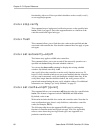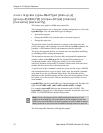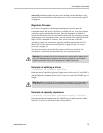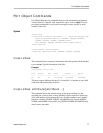
Chapter 2. CLI Syntax Reference
72 3ware Serial ATA RAID Controller CLI Guide
/c
x
/u
x
migrate type=
RaidType
[disk=
p:-p
]
[group=3|4|5|6|7|8] [stripe=
Stripe
] [noscan]
[nocache] [autoverify]
This feature only applies to 9000 series controllers.
This command allows you to change the existing configuration of a unit with
type=RaidType. You can make three types of changes:
• Increase the capacity
• Change the RAID level (with the same or increased capacity)
• Change the stripe size
The unit that results from the migration is subject to the same rules and
policies that apply when creating a new unit with the /cx add command. For
example, a valid number of disks and parameters must be specified.
The unit to be migrated must be in a normal state (not degraded, initializing,
or rebuilding) before starting the migration.
The destination unit must use all source disks and potentially augment the
number of disks in the disk=p:-p disk list. Unspecified parameters are
assigned the default values (stripe size of 64K, write cache enabled,
autoverify disabled, and ignoreECC disabled). Both source name and serial
number will be carried over to the destination unit.
A special case of this command is when the source unit has a type of RAID1
and destination unit has a type of single. In this case, the migrate command
splits both drives into two identical single disks. The disk name will be
duplicated on the destination units, but the source unit serial number will not
be carried over to the new unit. The new destination unit will have its own
serial number.
type=RaidType specifies the RAID type of the destination unit. Possible unit
types include raid0, raid1, raid5, raid6, raid10, raid50, or single.
For example, type=raid5 indicates the destination unit is RAID-5. The
type=single is a special case of the migrate command. It splits the source unit
RAID-1 or TWINSTOR into multiple Single units.
The following table illustrates valid migration paths:
Note: You can only migrate a unit to a RAID level that has the same or more
capacity as the existing one. A four-drive RAID 5 unit can migrate to a four-drive
RAID 0, but a four-drive RAID 0 unit cannot migrate to a four-drive RAID 5, without
adding another drive, due to the need for additional storage capacity for parity bits.


















